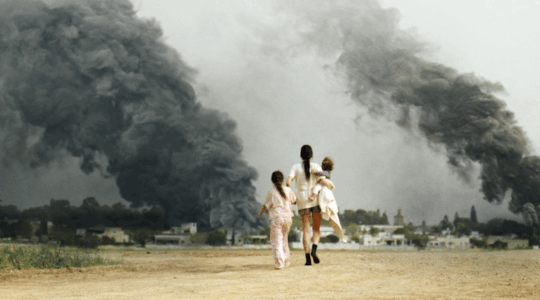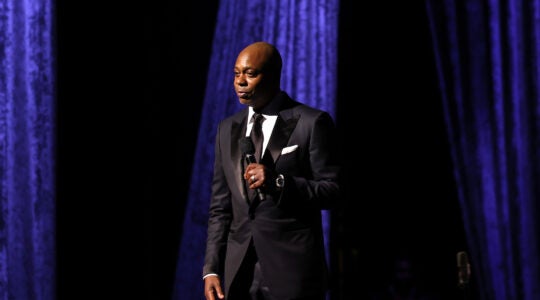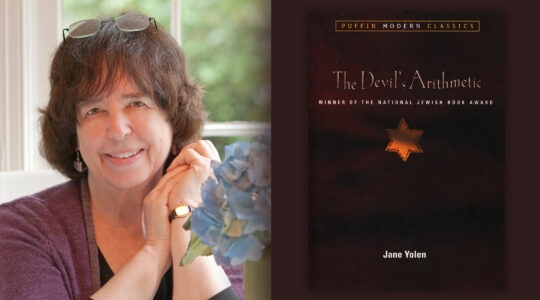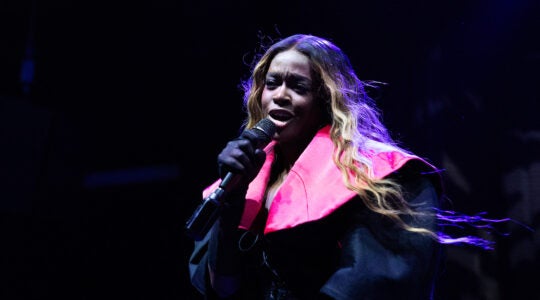
Rabbi Shlomo Carlebach during a visit to the Kotel in Jerusalem, early 1990s. (Shlomo Carlebach Legacy Trust)
BERKELEY, Calif. (JTA) — When David and Batsheva Miller left Israel for California in 1994, they sorely missed singer-spiritualist Rabbi Shlomo Carlebach and the moshav, or Israeli communal settlement, founded by Carlebach.
Nothing, even in Berkeley, compared to Shabbat on the moshav, Meor Modiin. So they created gatherings at their home, enlivening them with Carlebach melodies — what Miller calls “nusach Shlomo.”
“It was a landing pad for people coming back from Israel, including us, who were in shock at the wilderness we encountered,” Miller said. “Equally important, it was a blastoff for many people powering up to go to Israel.”
Fast forward to last November, when the Millers and friends launched the Mevorach Minyan of Berkeley, an independent, monthly Shabbat morning service at a rented hall that commemorates the blessing of the new moon.
It is one of the latest Carlebach minyans around the globe. The services, which use Carlebach melodies, range from Crown Heights in New York’s Brooklyn borough to Jerusaelm, and take place both in independent minyans and established synagogues.
“If you wanted to count them all, you couldn’t,” said Rabbi Naftali Citron, the spiritual leader of New York’s Carlebach Shul.
The growing ranks of minyanim are a part of a surge of recent interest in Carlebach, who was Citron’s late great-uncle. Urim Publications and the Carlebach Legacy Trust recently released “Evan Shlomo, The Torah Commentary of Rabbi Shlomo Carlebach: Genesis, Part I,” authored by Carlebach and edited by Rabbi Shlomo Katz.
After sellout runs in South Florida and New Orleans, the musical “Soul Doctor: The Journey of a Rock Star Rabbi,” written and directed by Daniel Wise, is poised to open on Broadway this fall. Since Carlebach’s passing in 1994, his eldest daughter, Neshama, has toured widely, recording eight albums. Her latest is a children’s collection for the PJ Library, which delivers Jewish books for free to 65,000 families nationwide. Neshama’s CD, “Higher & Higher,” in which she performs her father’s music with the Rev. Roger Hambrick and members of the Green Pastures Baptist Church Choir, was a Grammy entrant last year.
Countless other popular bands and individuals perform Carlebach’s music to an ever-expanding international fan base. They include Moshav, Soulfarm, Chaim Dovid, Benyamin Steinberg and Rabbi Katz.
But perhaps most notable is the extent to which Carlebach’s melodies have permeated synagogue services across the world.
“I’m always amazed by how much Shlomo lives and how much his music affected his time and our time,” said Ari Goldman, a journalism professor at Columbia University who wrote Carlebach’s obituary for The New York Times. “It is very much ingrained in our liturgical life, our celebratory life and our musical life.”
The Millers’ experience of longing for Carlebach tunes is a common impetus to launch a minyan, according to Citron. “Once you get used to this kind of davening, you can never go back,” he said.
Carlebach tunes have spread to all types of shuls – Orthodox, Renewal, Reform, Reconstructionist, gay, Conservative and Chabad. But Carlebach minyanim vary widely. Some groups pray in private homes once a month. Others meet in synagogues, as a supplement or alternative to traditional prayers. One popular Carlebach minyan in Jerusalem is run out of a bomb shelter in the neighborhood of Nachlaot.
The most notable characteristics of a Carlebach service are the melodies, pacing and degree to which congregants participate. Some minyanim also adopt a neo-Chasidic approach, channeling Carlebach and the Chasidic masters in teachings and sermons.
When Orthodox Congregation Ramath Orah in New York introduced a Carlebach Kabbalat Shabbat a few years after Carlebach’s passing, it “completely revived Friday-night davening,” said Goldman, a longtime member. It draws not just Orthodox Jews from the neighborhood but students and faculty from the nearby Columbia University and the Conservative movement’s Jewish Theological Seminary.
In Los Angeles, a Carlebach minyan began 17 years ago when friends celebrated the Shabbat before the wedding of co-founders Stuie and Enny Wax. After years of meeting in spare rooms at local synagogues, the Happy Minyan now draws 100 to 150 people to services at The Karate Academy of Pico-Robertson.
Organizers transform the dojo into a sanctuary by removing floor mats and covering wall-to-wall mirrors with white velveteen. They cart in a podium, an ark, a mechitzah to separate men and women, prayer books, prayer shawls, chairs and decorations. They also offer child care and catered kiddush lunches. The community-led effort has no formal membership, rabbi or office staff.
Prayers at the Happy Minyan are infused with ecstatic singing and dancing on both sides of the mechitzah, niggunim — wordless melodies — and impromptu percussion on a wooden podium. Cantor Yehuda Solomon, lead singer of the rock-folk band Moshav, learned the melodies firsthand; Carlebach was his next door neighbor at Meor Modiim.
“This type of davening demands that you put your whole self into it,” said David Sacks, a Happy Minyan founding member who grew up across the street from the Carlebach Shul in Manhattan. “It adds another dimension where you can’t just say it, you’ve got to pray it.”
Neshama Carlebach says the universal appeal of Carlebach music doesn’t surprise her.
“My father was unlimited and he was more powerful than anyone understood,” she said.
Her younger sister, Nedara (Dari) Carlebach, a married mother of two living in Zichron Yaakov, Israel, says Carlebach music can be characterized by a unique capacity to unify, just like him.
“My father would start a concert with a roomful of strangers and within one song, you could feel the electricity in the air,” she said. “In videos, you see the melting-down of walls and by the end, everyone is singing and dancing, holding hands. It was like heaven came down, the ceiling opened and the angels were in the room dancing with us.”
(Lisa Alcalay Klug is the author of “Cool Jew: The Ultimate Guide for Every Member of the Tribe,” and the forthcoming “Hot Mamalah: The Ultimate Guide for Every Woman of the Tribe.”)
JTA has documented Jewish history in real-time for over a century. Keep our journalism strong by joining us in supporting independent, award-winning reporting.





